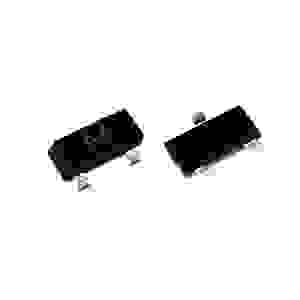Zener diode is an electronic component that utilizes the characteristics of semiconductor materials to achieve voltage stability in circuits. Its core function is to operate in reverse breakdown state, maintaining stable voltage at both ends by adjusting the current, and widely used in power circuits, voltage reference, surge protection and other fields.

1、 Definition and core functions
Zener diode, also known as a Zener diode, is a special type of diode. Unlike ordinary diodes, it is specifically designed to operate in reverse breakdown state, where the voltage remains almost constant and the current can vary over a large range. This characteristic makes it an ideal voltage regulator, which can provide stable voltage reference for circuits or protect sensitive components from overvoltage damage.
2、 Working principle
Zener diodes operate based on two types of breakdown effects:
Zener breakdown: occurs at low voltages (usually<5.6V), caused by a strong electric field directly breaking covalent bonds and generating electron hole pairs.
Avalanche breakdown: occurs at high voltage and is caused by a chain reaction of carrier accelerated collision ionization.
When reverse biased, when the voltage reaches the breakdown voltage (VZ), the diode begins to conduct, and the current increases sharply, but the voltage change is small. By using an external current limiting resistor, the current can be adjusted to maintain voltage stability.
3、 Key parameters
Voltage regulation (VZ): The stable voltage of a diode during reverse breakdown, typically between 1V and 200V.
Maximum operating current (IZM): The maximum reverse current that a diode can withstand, exceeding which may result in thermal failure.
Dynamic resistance (RZ): The ratio of voltage change to current change (RZ=Δ VZ/Δ IZ), reflecting the accuracy of voltage regulation. The smaller the value, the higher the accuracy.
Temperature coefficient (TC): The ratio of voltage regulation to temperature change (ppm/℃), and Zener diodes typically have a negative temperature coefficient.
Maximum power consumption (PZM): The maximum power dissipation that a diode can withstand (PZM=VZ × IZM), which is related to packaging and heat dissipation capabilities.
4、 Type and Characteristics
Zener diode:
Features: Utilizing the Zener breakdown effect, suitable for low voltage stabilization (<5.6V), with a negative temperature coefficient.
Application: Low voltage power supply circuit, voltage reference.
Avalanche diode:
Features: Utilizing avalanche breakdown effect, suitable for high voltage stabilization (>5.6V), with positive temperature coefficient.
Application: High voltage power supply circuit, surge protection.
Temperature compensation diode:
Characteristic: It has a negative temperature coefficient and is used to offset the temperature drift of other components.
Application: Precision voltage reference, temperature sensor.
Adjustable voltage regulator diode:
Features: By setting the voltage stabilization value through external resistors, it can flexibly adapt to different needs.
Application: Programmable power supply, experimental circuit.
5、 Application Fields
Power circuit: Provides stable voltage for microprocessors and analog circuits to prevent voltage fluctuations from causing faults.
Voltage reference: As a reference voltage source for ADC and DAC, it ensures measurement accuracy.
Surge protection: Absorbs overvoltage in the circuit and protects sensitive components (such as CMOS chips) from damage.
Automotive electronics: Provides stable voltage in car chargers and ECUs to adapt to harsh environments.
Communication equipment: Stable operating voltage in base stations and switches to ensure signal transmission quality.
6、 Development Trends
High precision: By optimizing materials and processes, the voltage stabilization accuracy and stability are improved to meet the requirements of precision measurement.
Miniaturization: Adopting micro packaging (such as SOT-23, DFN), the size is reduced to 1mm × 0.6mm, suitable for portable devices.
Integration: Integrating with resistors, capacitors, and other components to form a voltage regulator module, simplifying circuit design and improving reliability.
Intelligence: Combining temperature sensors and compensation circuits to achieve adaptive voltage regulation and improve environmental adaptability.
Low power consumption: By reducing operating current and static power consumption, the battery life of battery powered devices can be extended.
7、 Typical application cases
1N4733A: 5.1V Zener diode, used for power circuit stabilization, providing stable 5V output.
BZX84C3V3: 3.3V avalanche diode, suitable for low dropout linear regulators (LDOs), supplying power to microcontrollers.
LM4040: Adjustable voltage regulator diode, set the voltage regulator value (such as 2.5V to 40V) through an external resistor, used for programmable power supply.
TL431: Programmable precision reference source with integrated voltage regulator diode and operational amplifier, widely used in feedback loops of switching power supplies.
Zener diodes play a crucial role in electronic circuits due to their unique voltage regulation characteristics. With the continuous advancement of technology, its performance will continue to improve and its application fields will further expand.
